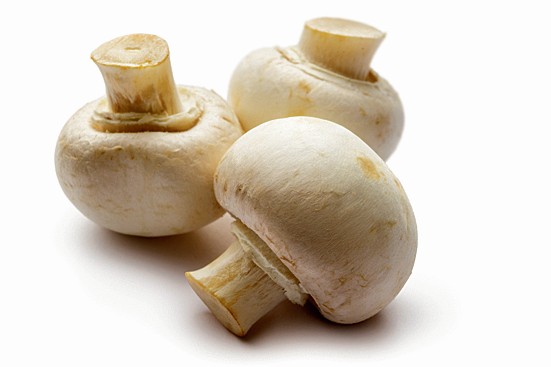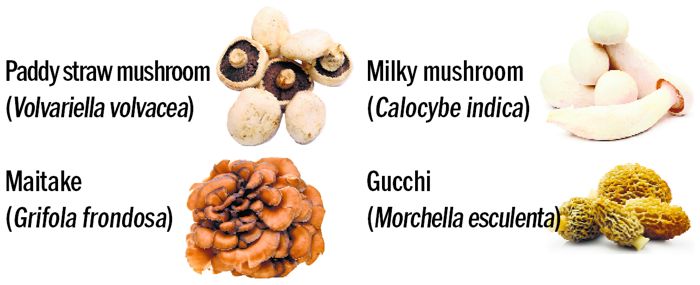
White button mushroom (Agaricus bisporus)
SS Chahal
INCREASING farmers’ income is an imperative requiring multiple interventions in view of the input-intensive, low-profit agriculture and the diverse pattern of farming in the country. Some alternative agricultural activities are highly productive; they utilise byproducts and employ locally available manpower to operate, manage and maintain production. One such activity is mushroom cultivation, which consumes agricultural residue, including wheat and paddy straw, requires less space/area and has the potential to enhance the income from farming. Even as a freestanding venture, it is potentially a profitable option for small and landless farmers.
Crop Diversification
Commercial cultivation of mushrooms commenced in India under the patronage of the Food and Agriculture Organisation (FAO) in 1961 in Solan (Himachal Pradesh); it got an impetus with the establishment of the Directorate of Mushroom Research of the Indian Council of Agricultural Research (ICAR-DMR). The hill town is known as the ‘Mushroom City’ of India. Four types of mushrooms are mainly grown commercially in the country. White button, a temperate mushroom, has a share of more than 70 per cent. It is also predominant in tropical and sub-tropical regions. Oyster mushroom, with 15-16 per cent share, is grown in the sub-tropics and northeastern states. Paddy straw mushroom (around 7 per cent) and milky mushroom (3 per cent) are grown seasonally in tropical and sub-tropical regions. Shiitake, another edible and medicinal mushroom, grown on wood logs, sawdust and corn cobs and supplemented with wheat and rice brawn, is gaining popularity for general cultivation. Mushrooms are now grown in almost all states of India. Haryana, Odisha, Maharashtra, Himachal Pradesh, Punjab, Gujarat, Uttarakhand and Tamil Nadu are the major contributors, ranging from 7 to 13 per cent share in the total production. Per capita consumption (about 80 gm) in India is slowly increasing, but it is still far less compared to China (1.6 kg) and the US as well as Europe (1.5-3 kg). To promote mushroom production and consumption, it is necessary to spread awareness among the masses about production technologies and qualitative food status. Many people wrongly consider it as non-vegetarian food.
Fungi family
Mushrooms belong to the group of organisms called fungi. They lack green matter (chlorophyll) present in plants and grow on dead and decaying organic material. From these decaying substrates, they absorb nutrition with the help of fine thread-like structures (mycelium) which penetrate into the substratum and are generally not visible on the surface. After the mycelium has grown profusely and absorbed sufficient food material, it forms the reproductive structure, which generally comes out of the substrate and forms the fruiting body (mushroom). The fruiting body may be umbrella-like or of other shapes, sizes and colours.
Mushrooms are highly nutritious and a potential substitute for muscle protein due to their high digestibility. They are packed with vitamins, minerals and fibres, low in calories and sodium and free from fat, cholesterol and gluten, with exceptionally high content of potassium (more than 400 mg per 100 gm) and containing vitamins such as thiamine, riboflavin, B6 and B12. Mushrooms are the only vegetarian, non-fortified dietary source of vitamin D. A number of bioactive compounds available in mushrooms have immunomodulating properties; they are also effective against tumour growth and are antioxidant, antidiabetic and antiallergic too.
Handling and procurement of spawn required for seeding the substrate are critical for harvesting quality produce. Establishing an ideal spawn production laboratory needs good training, precision and skills with a capital investment of Rs 15-18 lakh, which itself is a profitable, independent agri-business activity for educated youths. Seasonal and small-scale growers should procure it from accredited private or government sources. The supply of free or subsidised spawn by government institutes can be of great assistance to rural farmers and bring more into the fold. Setting up own units for raising spawn is viable for round-the-year growers.
Major mushroom varieties
- White button (Agaricus bisporus)
- Oyster mushroom (Pleurotus spp.)
- Paddy straw mushroom (Volvariella volvacea)
- Milky mushroom (Calocybe indica)
- Shiitake (Lentinula edodes)
- Lingzhi or reishi (Ganoderma lucidum)
- Maitake (Grifola frondosa)
- Gucchi (Morchella esculenta)


The government has permitted the establishment of ‘controlled, conditioned’ export units which don’t face major problems regarding canning, value addition and marketing. But there are limitations for small and rural growers who have to sell it afresh. Because of a very short shelf life of the produce and the absence of refrigerated transport facilities over long distances, they have to explore nearby urban markets. Seasonal production causes oversaturation and sale at unremunerative prices during winter months. Unorganised marketing is a big disadvantage and an impediment to expansion. For efficient marketing, public sector undertakings, organised retailers and grower associations should opt for innovative packaging using environment-friendly biodegradable material under brand names, thus creating an organised distribution network and retail chain system. An estimated loss of up to 25 per cent occurs due to inappropriate post-harvest management practices like harvesting, storage, preservation, processing and marketing, which can be minimised through comprehensive extension activities, organising on-site training programmes for prospective growers round the year and low-cost polyhouse/greenhouse cultivation. There is a need for policy interventions to encourage mushroom farming as a cottage industry by supporting cooperatives and farmer producer organisations, creating mushroom-specific agencies/boards, instituting centralised procuring and processing units to protect small and scattered growers from a seasonal glut, ensuring price stability, introducing and developing spawn standards, and establishing state-of-the art compost and spawn centres for the supply of ready-to-use compost and spawn. Aspects like the use of spent substrate as fertiliser and the development of food safety standards for fresh and processed mushrooms also require due attention.
Components of a mushroom farm
- Composting unit
- Outdoor phase-I composting platform or indoor bunkers/aerated chambers
- Indoor phase-II in peak heating/bulk past-chamber
- Peak heating chamber
- Bulk pasteurisation chamber
- Cooling of compost in summer months is a special requirement
- Casing pasteurisation chamber
- Spawn unit
- Spawn laboratory
- Cropping unit
- Seasonal cropping rooms
- Environment-controlled cropping rooms
- Environment-controlled airconditioning and forced air circulation
- Ancillary units
- Post-harvest handling unit
- Pre-cooling chamber
- Canning hall with canning line
- Packaging room
Growing diverse types of mushrooms is preferable to dependence on the white-button type. China is growing about 60 types of mushrooms. India needs to strengthen its research & development programmes for making the most of biodiversity and focusing on improvement using biotechnological tools. Other priorities should include expanding the cultivation base of medicinal mushrooms like lingzhi or reishi and maitake and introducing highly priced special-type gucchi. In 2013, an ICAR-constituted research advisory committee made these recommendations. In 2022, the ICAR-DMR announced the development of protocols for successfully producing fruiting bodies of the gucchi mushroom. Validation and adoption of such technologies by farmers can be a game-changer for enhancing their income.
Scope for growth
India recorded cumulative aggregate growth rate of 6.15% for mushroom production for 2000-19

The author is ex-VC, Maharana Pratap University of Agriculture and Technology, Udaipur
Send your feedback to [email protected]
Join Whatsapp Channel of The Tribune for latest updates.



























